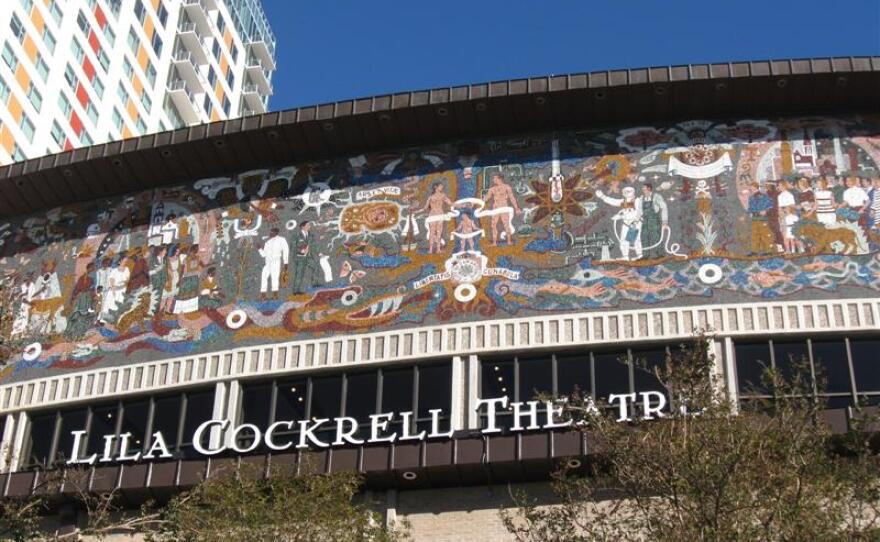Big changes are coming for one of San Antonio's most distinctive works of public art.
The River Walk barge tour totes tourists downtown on the San Antonio River, then to the Henry B. Gonzalez Convention Center area, where it turns around.
There is the Lila Cockrell Theatre. It's named after the first female mayor of San Antonio.
Right above the theater's entrance, a 130-foot wide, 30-foot tall mosaic overlooks the river. Due to its placement, and the convention center, this massive work of art has labored in obscurity its entire life.
"Juan O'Gorman was a remarkable Mexican architect/artist of the 20th century," says Catherine Nixon Cooke, who wrote the book on the art's creator. It's called Juan O'Gorman: A Confluence of Civilizations.
"Juan O'Gorman was the epitome of that title. His father was an Irish mining engineer, and his mother was a beautiful woman from Guanajuato, Mexico."
O'Gorman grew up as the Mexican mural tradition was exploding. O'Gorman and his good friend Frida Kahlo were fascinated by one of those muralists.
"They watched Diego Rivera do his very famous mural in the courtyard of their school. He was so intense and fierce, and he carried a gun in his belt, and they just thought it was quite fabulous."
Eventually, Frida and Diego married, and when O'Gorman graduated from school as an architect, he landed two high profile clients.
"When Frida married Diego, they immediately asked Juan O'Gorman to build them their first home, which, they called it the Casa Estudio because it's a house and a studio."
O'Gorman's architecture career took off, as did his painting career. He too became a muralist, gaining an international reputation. He then landed his most famous job ever at the National Autonomous University of Mexico--UNAM.
"Yes, I'm familiar with the Library Building in Mexico City, which is absolutely iconic, and amazing. Covered on all four sides, with those mosaics made of rocks," said Susan Toomey Frost.
Frost has studied tile mural art all her adult life and wrote the book Colors on Clay. That library's distinctive four-sided mosaic mural was enormous, and caught the eye of San Antonians who visited the Mexican capital. Fast forward to the mid 60s, at a time when an important event loomed: San Antonio's 250th anniversary.
"The Steves--Marshall and Patsy--had seen the wonderful library in Mexico City and felt that his work really did complement the theme of the fair," said Cooke.
And so as San Antonio planned the 1968 World's Fair, benefactors funded its public art, including the one at the Lila Cockrell. Frost says the artist took the fair's "Confluence of Civilizations" theme literally, depicting a converging timeline of European and new world cultures.
"With the right side being European, Greek, Roman civilization. The left side everything we draw from South America and Mexico that is so present here in San Antonio. And in the middle--as if San Antonio were in the center of civilization!" she laughed. "It all comes together here, like with the astronaut and the cowboy, and things that are very Texas."
The massive piece of art was built of about 400,000 rock chips cemented into meter square tiles.
"There are twelve colors in the mural, and eleven of them are natural stones from Mexico. There was one shade of blue that he could not find, and that they had to get from Italy," said Cooke.
The production of the tiles was completed in Mexico by October of 1967, and they were trucked to San Antonio.
"HemisFair was scheduled to open in April of 1968, and they had to get all those panels up on the building, and it was like doing a giant jigsaw puzzle. Each one had to be handled VERY carefully because they were so fragile before they got up there and installed."
"This guy used rocks," said Frost. "Rocks aren't going to go away; they're naturally colored; there are no dyes or anything in there."
O'Gorman completed the massive project to much acclaim as HemisFair opened, but its placement in the shade of the Gonzalez Convention Center mostly blocked its view. In the last couple of years though, the convention center has been torn down and re-built a few hundred yards to the east . Now, Confluence can finally can be seen, which delights Cooke.
"There it is! It's magnificent, and I notice it every time I drive by."
Frost says Confluence is a masterpiece.
"I consider this the most important public art that we have in all of Texas, and certainly South Texas."
Cooke says the piece's message has worn well.
"I think that metaphor, and that message, that we are a confluence is as powerful and important today, maybe even more so, than it was 50 years ago when it was created."
Frost puts it this way.
"I think we're indivisible with Mexico. We were Mexico. We were formed from the same clay."
The River Barge view of Confluence is wonderful, but it's no longer the only way to see it.
Find more on Catherine Nixon Cook's book here.














